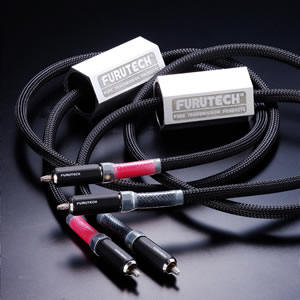|
|
LESTER J. MERTZ'S SYSTEM
LOUDSPEAKERS
DIY - 1. LJM
Originals, Transmission Line w/ Dynaudio 17W75 and Morel MDT30, 2. LJM
Modified, BK16 – folded horn w/ Fostex FF165K and Peerless Soft Dome, 3. LJM
Originals, Floor Stander, w/ Vifa P17WJ and Vifa DX25SG, 4. LJM Modified,
Dynaudio "Aries" – (currently on loan to Tim Stant), and 5. LJM subwoofer, w/
Audio Concepts AC12.
ELECTRONICS
Blue Circle BC21.1
preamplifier, Linn phono stage, and Sonic Frontier Power 1 (55w)
with Svetlana's 6550c Output, and 6N1P Drivers, B&K ST 140 (105w), and Sound
"Valve 110 SE" (on loan from Fred Kat) amplifiers.
SOURCES
Arcam CD 33 T, Linn
LP12, Grace 707, Signet Mk 110 E (mc) into Monolithic PS 1.
CABLES
Audience Au24 (on
loan from Keith Oyama), Ridge Street Audio Design, "Poiema!!", DH Labs
Air Matrix, DH Labs Silver Sonic, LJM, RS microphone, Maple Shade Double
Helix, Synergistic Research Active Looking Glass, van den Hul The
Second, van den Hul D300 Mk III Hybrid interconnects. van den Hul D352
Hybrid speaker cables. Blue Circle, BC02, Kimber Kord, Synergistic
Research, Active, AC Master Coupler, and LJM Originals, Marinco Plugs w/Belden
14-AWG AC cords.
ACCESSORIES
Acme Audio Labs, cryogenic treated outlets and
Hubbell, outlets, Mod Squad Tip Toes and cones, Mana Sound Frame,
FIM 305 (roller balls), Vibrapods, Maple Shade Iso-Blocks, Maple Shade Maple
Boards, Marchland XM9 electronic crossover, Boos Blocks, Rock Maple Granite
Slab, Target Stand TTSA5, LJM Wood Blocks/Equipment Stands, VPI 16.5
(record cleaning machine).
|
|
I'll just cut to the chase and tell you that my
initial impression of Furutech Reference III Alpha cables are that they are a
sonic leap forward! They are one great line of cables! So if you are interested in new
interconnects or speaker cables of the best "high end" variety (along with being
not that expensive—well not on high-end audio terms)
read on!
Now that we
have gotten that out of the way, here is a little of the technical background to
Furutech's new line of interconnects and speaker cables. First a summary, kind
of a "readers digest" version of the cables' new features, so if you want or
need more information than what's here, check out the Furutech website. If you
insist on doing your due diligence, that is, finding out everything you can
there are other sites for information on the different technical processes used
in making cables and heaven forbid, there may even be other reviews to
check-out.
I know most of
you who keep up with new things in the audiophile world are probably already
aware of the Furutech power line products such as their power distribution
boxes, premium wall outlets and the male and female power cable connectors. You
will find many of these hyper-quality connectors on other manufacturers' power
line products. Furutech has recently jumped into the interconnect market in the
USA, as they have been available in Japan and Europe for some time now. So,
here's the skinny (Navy talk, for the facts.)
Furutech is a
Japanese company, started in 1988 that uses an extremely high purity PCOCC
process they call α(Alpha)-OCC for single crystal copper for
analog, digital and power products. It sells
their α(Alpha)-OCC (pure copper by Ohno continuous casting) cable both in bulk and in
factory terminated products. In their Reference line, the α(Alpha)-OCC wire, (30 pieces
of 0.18 mm gauge in three bundles—for interconnects) and all of the metal
components are treated by Furutech's "Two-Stage Alpha process". The first stage
consists of the super cryogenic step followed by demagnetization treatment as
the second step.
The cryogenic
step, cooling materials to low temperatures to change their properties, is often
touted in the product information packets and has almost become the standard
buzz word phrase for any expensive power outlet. Furutech's custom treatment is
an advanced cryogenic technology that uses liquid carbon dioxide (-70 degrees
Centigrade),
then liquid nitrogen (-196 degrees Centigrade) and finally liquid helium (-250 degrees
Centigrade) in
the making of their cables. Note that only the wire and metal are treated in
this cryogenic step. Getting anything that cold other than the metal itself is
not a good idea, as it can cause plastics to weaken or even fail when used in an
AC power line application. Therefore, other manufacturers may not take things to
the temperature extremes used in the Furutech Alpha process, but if they do not,
then they are not getting the full benefit of the cryogenic treatment. It is
these super low temperatures that relieve internal stress by changing molecular
structures in the metal—leading to audible improvements such as increased
resolution, especially micro-details, clean backgrounds and wide bandwidth.
The Alpha
process also uses a demagnetization step, which is a patented Furutech process.
It is not one of ordinary super magnets, but instead uses what they call their
"attenuation method" to eliminate any possible magnetization with the metals and
wires. This technology provides positive sonic effects over standard methods.
Both of these Alpha process steps are engineered to ensure the lowest noise and
distortion levels in their cables.
FYI, the
Furutech's α(Alpha)-OCC uses Professor Ohno's (Chiba Institute of Technology of Japan)
patented process for manufacturing single crystal copper by heated mold
continuous casting. The resulting small rods of copper are then drawn into long
wire producing crystal grains greater than 700 feet in length. The long
single-crystal wire has attributes that are ideal for audio purposes such as low
electrical resistance, corrosive resistance, rapid transmission of signal and
high resolution.
The old story
of copper purity rated as four nines (99.99%), six nines (99.9999%) and so
forth, meaning the specification of percent purity, are not relevant with the
α(Alpha)-OCC cables because of the superior grain structure and surface finish. Cable
and wire construction by the use of Ohno's cast rod technique leads to a very
high quality surface finish that has been found to have more of an effect on the
cable sound than previously suspected.
Another shortcut manufacturing issue is not applying the proper insulation in a timely
manner, that is, as fast as possible once the wire is through the die so as to
minimize airborne contamination issues. The finely drawn surface finish of the
α(Alpha)-OCC wire provides better cable longevity by exhibiting that tighter surface
grain structure, which helps reduce chemical contamination during processing,
that is, before being covered by the protective insulation. Insulation is
another area that we are just now becoming aware of as sonically important
issue. Early audio cables were just covered with colorful PVC
(polyvinylchloride) to differentiate them from the standard black cover used by
the original wire manufacturer. Since then we have found that the PVC insulation
breaks down over time releasing reactive chemicals (plasticizers) into the
conductors producing undesirable contaminates which deteriorate the sonic
qualities of the cable. Furthermore, PVC's sun exposure to UV (Ultraviolet
radiation) leads to increased break down of the insulation that allows
undesirable airborne contaminates a chance for additional detrimental reactions
with the conductors. Newer insulating techniques are using halogen free
compounds such as polymerized silicone and other materials that avoid the old
PVC break down issues. All of the improved manufacturing techniques and better
wire qualities add significantly to the value of high-end audiophile grade
interconnects speaker cables and video cables, adding years of life to your
investment.
The Reference
III cables use Furutech's GC-303 antimagnetic and electromagnetic interference
(EMI) absorbent coatings in their design. This proprietary material is found in
the hexagonal metal fixture placed about 8 inches from one end. The cable is a
completely passive design and there are no capacitors or reactive components
hidden within the fixture. This module is covered with a dark green felt bag
embroidered with the Furutech Reference III logo, very plush looking. The cables
also have double shielding that provides extreme low noise, eliminating RFI and
EMI from the signal path. As the world becomes more sophisticated adding more
mobile phones, blue tooth devices and increasingly more electronics to our life,
we are also adding more sources of interference to our precious audio systems,
increasing the need for the best shielding in our equipment. One of the reasons
that late night listening is always better than daytime is because of the
reduction in RFI and EMI at those hours reducing impact on your gear and
improving your reproduced sound.
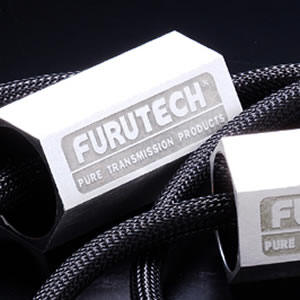
Reference III
interconnect cables feature low capacitance dielectric insulation, using Air-formed HDPE (High Density Poly-Ethylene) and natural fillers as barrier layers
for the double electrical shields leading to a quieter cable.
The RCA locking
connectors are made of Rhodium plate over non-magnetic phosphor bronze. These
connectors are similar to the famous WBT types and I could not help but notice
the unusual center pins of the RCAs—they are multi-faceted wires for superior
contact and outstanding transmission.
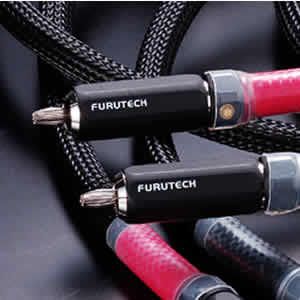
Many internet
audiophiles are reacting to the cable market and high pricing by saying that
today's cable descriptions are all hype, snake oil or worse. Those of you that
have been involved with this hobby for years have seen similar reactions to both
equipment and software in the past. Remember the amplifier wars of the sixties "all amps sound the same" and you know they do not. Then it was the turntable
debates of the seventies: "how can just the spinning of the record affect the
sound?" Virtually all of the makers that did not evolve are either extinct or
currently having their nameplate purchased and used for products from the Far
East. In the eighties there was the great media change with the introduction of
the CDs: "perfect sound forever." Well, we all know what that promise meant.
Nothing! Then it was the SACD/DVD-A verses the Redbook CD debates. What is the
current debate—Blue Ray verses the HD DVD?
A cottage
industry of cable makers has flourished over the internet. Have people been
bitten by quick buck hucksters? Sure they have, but this does not mean that
every cable is nothing more that a piece of wire. Naysayers argue—why not
spend your money on more equipment and stay with the basic cables. In time,
cables will be recognized as being as important as any other part of the chain
in achieving great sound. By now, you might be saturated with these peripheral
issues and are ready to get back to how these Furutechs sound.
Initially, I
added just one pair of interconnects, running between one of the Arcam CD 33T
dual outputs and the Blue Circle BC 21.1 line stage inputs. This allowed
comparison by just switching to the selected input on the line stage. At first
listen the Reference III did not sound overly impressive, but after thirty
minutes or so they started to bloom and I left them in the system for a week.
They certainly equaled my current cables ("the second" by vdh) with their top
end's beautiful delicacy and openness! Maybe just a tad less in ultimate low
bass depth but certainly very detailed in the frequencies they did cover. They
did not have the overwhelming shrill harshness common to other cables I have
auditioned at this price point. I had tried other single crystal cables, silver
cables, cables with voltage applied to their shields and so forth, and they all
delivered a lot of high frequency energy, but with the kind of sound that wears
you out after a while. This sound is characterized by an overwhelming metal
harshness. Once you have this harshness eliminated from your sound you never
want to go back. The Furutechs are musical.
Many
audiophiles are leery of the word musical. They think it means rolled-off and
lacking details. This is definitely not the case here. The Reference III cables
are extended and open in the top end and at the same time extraordinarily
inviting and clean in the midrange. They provide a wealth of nuance that leads
to genuine involvement with the piece of music playing. I listened to the entire
double CD from guitarist Paul Galbraith, Bach the Sonatas and Partitas (Delos DE
3232.) What an amazing experience! This guitarist has a unique sound that holds
you right there and the system did absolutely nothing to interfere with the
performance. This CD was brought over by an audiophile friend who is a classical
guitarist and we often share our guitar music finds with each other. He and I
listened together for a few minutes, when he asked if I was having trouble
breathing. I said, "No, that's not me it's on the recording." You can make out
Paul's breathing because of the microphone sensitivity and close positioning to
his guitar and body, as his guitar is held upright like a cello. He had listened
to the recording many times but had not heard this breathing on his expensive
home system. The Reference III cables capture his breath and playing technique
leaving nothing out. However, they do not overly accentuate making details
unbearable to listen to over the long haul. By the way, this CD is so good, that
even though he loaned it to me for the week, I went out and bought it just a few
days later. If you are a classical guitar music lover this is a must have
recording. I didn't want to be without my own copy even for a day.
I put on
several Alison Krauss recordings (Forget About It, Rounder 11661-0465-4 and
New
Favorite, Rounder 11661-0495-2) because of her angelic voice and beautiful tone.
She is something special to listen to and her sound is very useful for
evaluating gear. Most of her recordings have added reverberation (echo) and this
artificial artifact usually makes for a quick test of cables and systems. With
some gear and cables you can distinctly make out a disturbing graininess, an
overly accentuated brightness that leads an almost unbearable harshness in her
recorded voice. Remember the human vocal range is usually below 1000Hz, so
there is something else going on here in the octaves above those fundamentals.
The overtones can easily be in and above the 3000-hertz range where our ears are
most sensitive—any over accentuation leading to a harsh over wrought sound can
easily become fatiguing.
Upon adding the
second Furutech interconnect between the BC 21.1 and the Sonic Frontier' Power 1
(55-watts) the sound space opened up considerably, with the proverbial "raising
the curtain" effect. With all Furutech interconnects in the system it was a
special listening event. Believe me when I tell you they are very open without
being glaring, harsh and over the top. Certainly that very openness could push
things past the point of acceptability with some older CD recordings (pre
1990s) and certain gear, I'm thinking here of particular solid-state amplifiers
and certain speakers with metal dome tweeters. With a hard sounding system
adding these revealing cables may not be the answer for you. If this is your
chosen audio path then you simply must try them in your system before laying out
your hard-earned cash. Please be certain beforehand that you are able to return
things when you try any new gear or expensive accessory items in your system.
Returned items should have money back or specified restocking fee from the
dealer or manufacturer.
You may be
wondering just how I am hearing this openness on an all tube system, but these
pieces of gear are not laid back in any way and easily allow one to hear the
differences that cables make in the system. I have to digress here—a certain
manufacturer's representative once told me when I was buying one of his
expensive tube line stages that I would not have to worry about cables anymore,
because the line stage's input impedance was so high that all cables would sound
the same—equally wonderful. Weeks, many weeks actually, later after breaking
in that line stage I was trying different interconnects and was wondering just
what he had been listening to all that time to come up with such an erroneous
conclusion? The cables had an obvious effect on the overall sound. I say this,
every change and every damned thing sounds different, period.
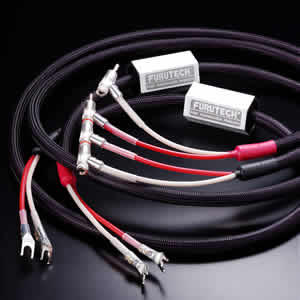
Lastly, I
installed the hefty Reference III speaker cables in place of my trusty Van Den
Hul D352 Hybrids (10-gauge.) The Furutech speaker cables have large spades at the
amplifier and expandable locking banana connectors at the speaker end, all
Rhodium plated. The main section of the cable, the black woven section is
flexible enough but the end leads are quite stiff and a handful in tight places
such as the output terminals of your amplifier. The same open attributes of the
interconnect cables were heard immediately after connecting the speaker cables,
but now with an extra expansion of the sound field and more layering of the
instruments. There was even more clarity across the audio frequency ranges
especially air in the upper registers. There was that speed, the instantaneous
delivery of the recorded sound that I thought was the exclusive providence of
the super kilo-buck amplifiers. I remember the first time I heard the Halcro
amplifier demonstration (with the Eggleston Works "Rose" speakers) at the 2000
CES. We were ushered into a large room with chairs set up in rows like a theater
and once they were filled the door was closed, and we were asked to be very
quiet and listen. Wow, there were things happening in the CDs that made the
music incredibly life-like and I never forgot it. With all of the Furutechs
installed they bring that kind of realism to my system.
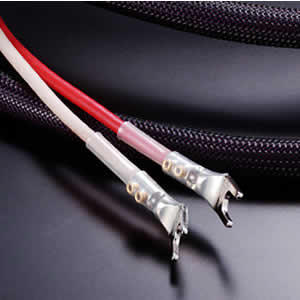
For a
solid-state session, I used my B&K ST-140 (105wpc) instead of the SF tubes and I
was impressed. If the B&K had sounded this good so many years ago, it may have
stayed in my system a lot longer. With the Furutech cables it was like having a
brand new amp, but unfortunately owners of this caliber of gear cannot imagine
buying cables in this price range. I also pulled out several different speaker
types to try with the Furutech speaker cables in the set up. The B&K with the
Dynaudio ported box was just divine, deeper and tighter than I have ever heard
from them. Solid state amplifiers just seem to be able to deal with the ported
boxes double humped impedance rise, (that jumps up to more than four or five
times the speaker's rated impedance,) better than the tube circuits. There was
no harshness in the top end either; in fact, the top on the B&K was slightly
depressed compared to the SF tubes.
I love the way that more of the music was emphasized
with the Furutech cables; it was a sonic miracle. The speaker cables portray the
music with an exceptionally fast paced delivery, one in which nothing lags
behind. The entire orchestra had a pace that moved along with a very realistic
speed. Listening to the Crouching Tiger Hidden Dragon (Sony) soundtrack was a
whole new experience. Explosive drum hits and crashing cymbals were scary and
caught you off guard with their live dynamics. It was like the amplifier had
suddenly doubled its power, and the sound had the major slam of the high priced
amps. The speaker cables were an obvious improvement within minutes of
listening. There is something beguiling about their performance and airy
effortlessness that tricks you into believing that you are listening live to the
real thing more often than not. You're My Thrill; Shirley Horn (Verve)
was another revelation. This Furutech sound had me enthralled on her
wonderful recording. By the way, I am certainly one who will miss her wonderful
jazz.
I loaned out
(big mistake) my beloved copy of Autumn in Seattle, with Tsuyoshi Yamamoto,
piano; Ken Kaneko, bass and Toshio Osumi, drums (First Impression Music) and
never got it back. After looking everywhere for the CD version that now seems to
be out of print, I finally broke down and bought the "hybrid" (SACD/CD)
version. Amazingly, the sound is even sweeter than I remember it being on the
original CD version and jazz aficionados will certainly appreciate this
beautiful recording and performance. This album is top shelf all the way, and
each time I play it someone comments favorably and asks where to buy it. It's
that good.
Everything in
audio, as in life, is a series of compromises; the musical presentation, the
details and whatever else you can think of are a series of trade offs in
engineering and value. It seems to me that Furutech has made these cable
products as vibrant, lifelike and balanced as they can without going over the
top into the glaring hyper-detailed presentation that wears me out. Most of us
will change our priorities over time and as we grow and mature with our musical
tastes and interests. The VDH cables have that balance of satisfying sound that
have kept them in my system against all challengers up to now. But, I think
Furutech may have come up with something better than anything I have heard up to
this point. Audio products can sometimes satisfy you in your quest for a brief
period and some of them—even over the long haul. However, because everything
changes as newer technologies come along and evolve, they make older
technologies sound dated and lacking in the life of the music. Furutech's
interconnects and speaker cables are a culmination of newer technology providing
brilliant energy and life to music. It is not one of those flash in the pan -
science fiction type breakthroughs, but instead a compilation of evolving
technologies that has led to better sounding cables. If you're working up the
quality / price scale, and most of us are, only you can decide if you're at that
point in your quest where you are ready to move up to the Furutech cables. For
me, I am trying to go for it. I am looking for my checkbook to see if I can
hurdle that "final frontier"—the bank balance. The Furutech cables are great!
Thanks to
Furutech, to Dave for sending them over, and to you for reading, Lester
J. Mertz.
A word or two from Dave Clark
Damn you Les... damn you... again one of our writers
beats me to the punch by clearly and succinctly (well, perhaps not all that
succinctly here ...Les did write quite a bit!) about a product that I also
had in house. Not sure what I can add to Les's review, but let me say that the Furutechs do offer a big, BIG sound that in many ways brings to mind a muscle
car of the 60s. J10 mentioned in an email how he felt that the cables possessed
a sonic signature that was like a big V8 that's only ticking over but
can burn it out when needed.... big and powerful with a nice sense of pedal
to the metal when called upon.
An excellent image to be sure. The Furutechs (as
compared to the Audio Magic Clairvoyant 4Ds) are "darker" in the sense that the
mids and up have less emphasis or presence. There is less "light" making them
sound bolder (heavier?) and solid. Solid in all respects; imaging, soundfield,
dynamics, bass, musicality ...you get the idea. Bold in the sense that the music
has serious heft and power. They have less edge to the music, perhaps
being a touch less delineated or detailed ...though this could simply be less noise and crap
getting into the signal and being interpreted as detail and resolution. Or the
difference between very good silver versus very good copper—copper with an
attention to eliminating noise and other external gremlins. Your call as to
preference.
As such, their shortcomings might be perhaps this
less apparent resolution or presence, though the Furutechs may be
more right than others. That is they do not shout out to be heard, nor do they
come across as splashy, flashy, and being all that! No, they seem to be rather humble in how
they present the finer details—all the little subtle things going on in the
sonic tapestry. They are there, they just don't prick you on the nose to make
themselves stand out. It is called listening to the music. With the Furtutechs,
that is what one will do.
These are very nice cables that will not break (or
as a V8, brake) the
bank. Beautifully finished and built to last through the next millennium, they
are highly recommended. Dave Clark
Reference III interconnects
Retail: $990 per 1.2 meters pair (RCA)
Reference III speaker cables
Retails: $1100, 2 meters stereo pair
Furutech
web address:
www.furutech.com
|

